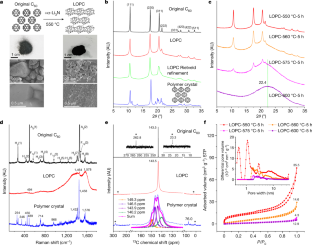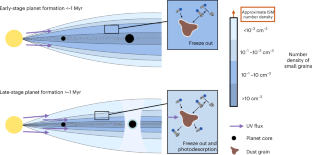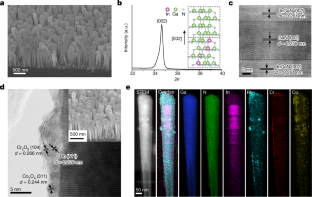フラーレンを窒化リチウムで加熱することで、新しい形の炭素が形成される The new form of carbon is formed by heating fullerenes with lithium nitride
2023-01-12 韓国基礎科学研究院(IBS)
炭素の最もよく知られた形態はグラファイトやダイヤモンドですが、それ以外にも、よりエキゾチックなナノスケールの炭素の同素体があります。グラフェンやフラーレンは、曲率がゼロ(平板状)または正(球状)のsp2混成炭素である。
一方、負の曲率をもつsp2混成炭素は「シュワルツァイト」と呼ばれ、理論的に提案されており、その発見は炭素材料分野の一部の科学者の夢であった。ある種のゼオライトの周期的な細孔の一部に、蒸着法で炭素を鋳型化できることがわかったが、細孔が狭いために鋳型化が不完全であった。このため、テンプレート法でカーボンシュバルツァイトを作ることはできなかった。
最近、韓国の基礎科学研究所(IBS)多次元炭素材料センターのRodney RUOFF所長と中国科学技術大学のYanwu ZHU教授らの研究チームが、新しい形態の炭素の発見を報告した。
この新しい形の炭素は、C60フラーレン(バックミンスターフラーレン、別名「バッキーボール分子」)の粉末を基材として製造された。C60をα-Li3N(αリチウムナイトライド)と混合し、1気圧の圧力をかけながら、適度な温度で加熱した。すると、α-Li3が触媒となってC60の炭素-炭素結合の一部を切断し、C60分子への電子移動によって、隣接するC60分子と新たな炭素-炭素結合を形成していることがわかった。Zhu教授とチームは、彼らの新しいカーボンを「長距離秩序化多孔質カーボン」(LOPC)と名付けました。
LOPCは、長距離周期性でつながった「壊れたC60ケージ」で構成されている。つまり、壊れたC60ケージはそれぞれ面心立方格子の格子サイトに中心を持ったまま、ある程度「開いて」互いに結合を形成しているのだ。これは、ある種の長距離周期秩序は残っているが、壊れたC60ケージがすべて隣のケージと同じというわけではない、というやや珍しい状況である。
LOPCの形成は、狭い温度と炭素/Li3N比の条件下で起こることが明らかになった。炭素とLi3Nの比率を5:1にして550℃まで加熱すると、バッキーボールの一部が破壊(一部のC-C結合が切れる)され、LOPCに見られる「壊れたC60ケージ」構造を発見することができた。
480℃以下の低温のLi3Nでは、バッキーボールは破壊されず、結合して「C60ポリマー結晶」を形成する。この結晶は、再加熱すると分解して個々のバッキーボールに戻る。一方、Li3Nの添加量が多すぎたり、600℃以上の高温になると、バッキーボールは完全に分解されてしまう。
この新しいカーボンはさまざまな方法で特性評価されたが、(実際)標準的な面心立方結晶格子の中で位置を保ちながらも、微妙に異なる「壊れたC60ケージ」が存在するため、その特性評価は容易でなかった。X線回折、ラマン分光法、魔法角回転固体核磁気共鳴法、収差補正透過電子顕微鏡法、中性子散乱法を用いて、この新しい形の炭素の構造を理解した。ニューラルネットワーク型のモデリングに基づく数値シミュレーションと上記の実験手法を組み合わせることで、LOPCが「フラーレン型」から「グラフェン型」の炭素に変化する際に生成する準安定構造であることが示された。
<関連情報>
- https://www.ibs.re.kr/cop/bbs/BBSMSTR_000000000738/selectBoardArticle.do?nttId=22427&pageIndex=1&searchCnd=&searchWrd=
- https://www.nature.com/articles/s41586-022-05532-0
C60から作製した長距離秩序型多孔質炭化物 Long-range ordered porous carbons produced from C60
Fei Pan,Kun Ni,Tao Xu,Huaican Chen,Yusong Wang,Ke Gong,Cai Liu,Xin Li,Miao-Ling Lin,Shengyuan Li,Xia Wang,Wensheng Yan,Wen Yin,Ping-Heng Tan,Litao Sun,Dapeng Yu,Rodney S. Ruoff & Yanwu Zh
Nature Published:11 January 2023
DOI:https://doi.org/10.1038/s41586-022-05532-0

Abstract
Carbon structures with covalent bonds connecting C60 molecules have been reported1,2,3, but their production methods typically result in very small amounts of sample, which restrict the detailed characterization and exploration necessary for potential applications. We report the gram-scale preparation of a new type of carbon, long-range ordered porous carbon (LOPC), from C60 powder catalysed by α-Li3N at ambient pressure. LOPC consists of connected broken C60 cages that maintain long-range periodicity, and has been characterized by X-ray diffraction, Raman spectroscopy, magic-angle spinning solid-state nuclear magnetic resonance spectroscopy, aberration-corrected transmission electron microscopy and neutron scattering. Numerical simulations based on a neural network show that LOPC is a metastable structure produced during the transformation from fullerene-type to graphene-type carbons. At a lower temperature, shorter annealing time or by using less α-Li3N, a well-known polymerized C60 crystal forms owing to the electron transfer from α-Li3N to C60. The carbon K-edge near-edge X-ray absorption fine structure shows a higher degree of delocalization of electrons in LOPC than in C60(s). The electrical conductivity is 1.17 × 10−2 S cm−1 at room temperature, and conduction at T < 30 K appears to result from a combination of metallic-like transport over short distances punctuated by carrier hopping. The preparation of LOPC enables the discovery of other crystalline carbons starting from C60(s).



